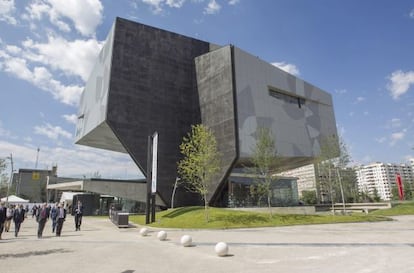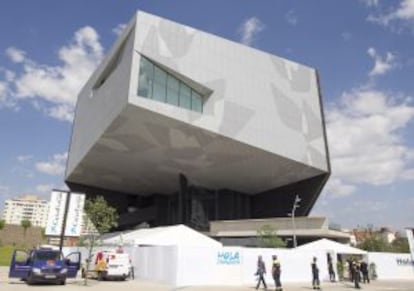New CaixaForum seeks “Guggenheim effect” in Zaragoza
Bank foundation unveils seventh cultural center, designed by prizewinning architect Carme Pinós

Two huge aluminum and concrete cubes lifted up on a transparent glass base in the heart of Zaragoza are the new essential stop-offs for anyone interested in the latest cultural trends in the city.
Designed by architect Carme Pinós, the seventh CaixaForum cultural center built by the charitable foundation of Spanish bank La Caixa is a unique building in which the severity of its basic materials combines with both natural and artificial light coming in through 1,600 perforated aluminum sheets that cover the three-story, 7,000-square-meter structure.
It is a unique building in which the severity of its basic materials combines with both natural and artificial light
The cubes host the center’s two halls dedicated to temporary exhibitions, one 780 square meters and the other 438 square meters. La Caixa has chosen a double exhibition of contemporary art, almost all of it from its own collection, to inaugurate the new building. Planos sensibles traces informalism in Spanish painting, while Narrativas de la imagen offers videos and photos taken in the last few years. Antoni Tàpies, Antonio Saura, Pablo Palazuelo, Manuel Millares, Miquel Barceló, Eduardo Chillida, José Manuel Broto, Jeff Wall, Javier Peñafiel, Ignasi Aballó, Sophie Calle, Willie Doherty and Eve Sussman are some of the names whose works feature.
One of the aims of those behind the project is for the CaixaForum-Zaragoza to encourage culture in the city in the same way as the Guggenheim museum has in Bilbao. Zaragoza already has several contemporary art centers, but lacks a place centralizing activities such as exhibitions, film, theater and topical debates.

For the moment, those who attended Saturday’s inauguration – including Prado Museum director Miguel Zugaza and Bertomeu Marí, director of Barcelona’s MACBA contemporary art center – were captivated by the beauty of the new CaixaForum. Pinós, who won Spain’s National Architecture Prize in 2010, explains the considerations she took into account in creating the building: “I wanted the city to feel involved in the museum and that visitors had the same feeling towards the city.” The Catalan architect thinks the museum has to be at the service of the content and the activities going on inside it. Unlike others, she doesn’t see the building as a star in its own right.
The two big cubes are suspended at different levels. At the topmost part sit the cafeteria and a restaurant affording panoramic views over the Expo 2008 site. On the ground floor, a feeling of space predominates, achieved through open areas and glass walls. Through a garden you then go down into a spectacular 252-seater auditorium in which the architect has played with wood to cover ceilings and walls with the same sheets that visitors will go on finding scattered around the building, creating a unifying effect.
Guests at the official inauguration hosted by La Caixa president Isidro Fainé were reminded that the project dated back to 2008 and that construction work began in September 2010, lasting three-and-a-half years at a cost of around €20 million.
Nimfa Bisbe, director of the La Caixa collection, said the building would host major exhibitions from CaixaForum’s circuit of seven centers and that, like in all of the others, the aim was to circulate and offer new readings of a collection of contemporary art considered one of the best in the world. Associate chairman of La Caixa Foundation Elena Durán said that, according to its estimates, the center would receive around 300,000 visitors a year. Until July 6 the public will be able to take advantage of the open-doors days to visit the center.
Tu suscripción se está usando en otro dispositivo
¿Quieres añadir otro usuario a tu suscripción?
Si continúas leyendo en este dispositivo, no se podrá leer en el otro.
FlechaTu suscripción se está usando en otro dispositivo y solo puedes acceder a EL PAÍS desde un dispositivo a la vez.
Si quieres compartir tu cuenta, cambia tu suscripción a la modalidad Premium, así podrás añadir otro usuario. Cada uno accederá con su propia cuenta de email, lo que os permitirá personalizar vuestra experiencia en EL PAÍS.
¿Tienes una suscripción de empresa? Accede aquí para contratar más cuentas.
En el caso de no saber quién está usando tu cuenta, te recomendamos cambiar tu contraseña aquí.
Si decides continuar compartiendo tu cuenta, este mensaje se mostrará en tu dispositivo y en el de la otra persona que está usando tu cuenta de forma indefinida, afectando a tu experiencia de lectura. Puedes consultar aquí los términos y condiciones de la suscripción digital.
Últimas noticias
Maduro pleads not guilty before the federal court in New York: ‘I am still the president of Venezuela’
A new test can detect Alzheimer’s from a finger prick
UN team enters Sudanese city of El Fasher after paramilitary massacre: ‘It’s like a ghost town’
A recipe for resistance: Indigenous peoples politicize their struggles from the kitchen
Most viewed
- Gilles Lipovetsky: ‘If you want to live better and fall in love, take Prozac, don’t look to philosophy’
- Alain Aspect, Nobel laureate in physics: ‘Einstein was so smart that he would have had to recognize quantum entanglement’
- Alvin Hellerstein, a 92-year-old judge appointed by Bill Clinton, to preside over Maduro’s trial in New York
- Why oil has been at the center of Venezuela-US conflicts for decades
- Cuba confirms death of 32 of its citizens in the US attack against Venezuela








































